Using inclusive language has become an increasingly important skill in modern society and it’s risen to the forefront in the past few months. Stanford University came under fire for its Harmful Language List late last year after it issued a guide meant to address harmful communications in its IT department. Although the guide itself was scrutinized, it became clear that it’s worth other teams taking a more thoughtful, more careful look at the language they use in the course of their work.
In the world of sales and revenue where people interact with one another as the majority of their job – and sometimes their success is dependent on how well they communicate – using inclusive language is a vital skill.
So what do we mean by inclusive language?
It means using words and phrases that avoid discrimination against certain groups of people, whether that is based on their gender, race, ethnicity, religion, or sexual orientation. It also includes words or phrases used in lieu of language that is violent in nature.
Using inclusive language is about acknowledging diversity, being respectful of people’s identities and experiences, and creating a safe, welcoming environment for every prospective customer or partner.
This guide is meant to be a guide for how selling teams can become familiar with and use inclusive language so it’s a skill every seller has and it becomes engrained in your culture. In this post we’ll cover:
What are the benefits of using inclusive language in sales and customer success
Building trust and rapport with current and potential customers
If your goal is to close new or expansion opportunities, strong relationships are the bridge that gets you there. This is especially true when an organization primarily uses a consultative approach. While using inclusive language won’t be the finishing move that clinches the deal, not training this skill opens reps up to the preventable risk of offending someone with a language-poor choice. Why take that chance when you can train yourself to create a warm, inviting atmosphere with your words?
Enhancing your brand reputation
The Diversity, Equity, and Inclusion profession saw a ton of growth in recent years, with 123% more job postings between May and September of 2020, in spite of the abrupt economic effects of the COVID-19 pandemic. Unfortunately, the traditional strategy to handle DE&I efforts internally for a company (hello, mandatory training and workshops) aren’t sufficient for folks who represent the company externally.
The perception of a brand is the culmination of media coverage, social media presence, industry rankings and awards, endorsements and partnerships, and word-of-mouth referrals from satisfied customers. That last factor is exactly why sales and customer success professionals should make the effort to incorporate inclusive language in their repertoire of external communication skills.
While using inclusive language isn’t going to be the top reason for a customer to refer you to someone in their network, being known as a company that truly embodies diversity and inclusion, including in every interaction with prospects and customers, is an excellent way to stand out. Being an easy, friendly, and invested partner to your customers starts with making everyone you work with feel seen and celebrated.
Strategies for using inclusive language
Avoiding stereotypes and generalizations
Stereotypes are often weaponized against minority groups both on an individual level, like bullying at school, and on the systemic level, like the stereotype that fathers and masculine-presenting parents are less capable of caring for children than mothers and feminine-presenting parents.
Even if you believe the stereotype is positive, like the stereotype that Asian Americans are good at math, it is much better for your relationship with your customer or prospect to get to know them as an individual, not assuming anything about where they grew up, what language they may speak, or what life experiences they may have had.
If you know something like their job title and some of the previous job titles they’ve had, it is absolutely appropriate to ask whether what you know about the responsibilities and frustrations that come with the job are accurate for them. This is a very common way to establish your experience with solving their set of business problems and is a great way to build trust and establish common ground.
Where a sales rep or CSM should tread carefully is in making any assumptions or sweeping generalizations based on:
- Ethnicity
- Gender presentation
- Age
- Size of their body
- Relationship status
Instead of making those comments, be curious about the person in front of you. Here is an example of how to establish rapport with prospects in ways that avoid stereotypes and generalizations:
For example, let’s say you are trying to establish rapport with your male prospect on a Monday by talking about what you both did over the weekend, you may hear an answer like “Oh, I was able to get out on the golf course for 9 holes, which was great.”
- Say this: “How did you get into golf? What part of the game do you enjoy the most?” Avoid assuming his relationship status, the gender of his partner, and avoid playing into the stereotypes.
- Instead of this: “Must have been great to get away from your wife/husband/partner!”
Avoiding culturally appropriative language
One of the beautiful aspects of language is that it is constantly evolving, whether that be through its native speakers, or through the assimilation of words from other cultures and languages. Unfortunately, the use of some of those by folks who do not know the context of the original language can be disrespectful to its’ native culture.
A good example of this is the use of the word “pow-wow.” The people who use it may not have a grasp of the original meaning, “medicine man” since its history is that English colonizers misused it to refer to gatherings of Indigenous medicine men, and later to refer to any gathering of American Indians.
There is usually an easy replacement to be made. Simply ask yourself, “What word would I use if I had to explain this to a five-year-old?” If we apply this question to the word “pow-wow”, we come up with words like “meeting”, “gathering”, or “meetup.”
Acknowledging and respecting cultural differences
There is understandable confusion between cultural appropriation and cultural appreciation. To be sure, the diversity of human cultures is something to be celebrated. That being said, culture is not a hobby or collector’s item.
The best way to fall on the side of cultural appreciation is to look for obvious context clues. “Appreciating culture often involves community, connection, and learning, whereas appropriation is typically an individual choice influenced by popular media.”
If you’re participating in a culturally significant ceremony and being asked to wear the traditional garb, make the effort to learn the history and symbolism of both. However, if you’re choosing to wear a piece inspired by a particular culture because it is trending on TikTok, rethink that decision and examine whether this trend is attempting to assign new meaning to this cultural marker.
Appreciating a culture does not have to mean wearing something. It can be awe and curiosity for important objects, understanding history, and partaking in delicious and unique foods without demeaning intentions.

Being aware of and addressing ableist language
According to the CDC, in 2022, 1 in 4 adults in the United States have some type of disability and many disabilities, such as autoimmune disorders, epilepsy, and chronic fatigue syndrome. Ableist language can be much less obvious or well-known compared to racist and sexist language. It often goes unchallenged because of the stigma disabled individuals face.
Many disabled people choose to remain silent when ableist language is used because speaking up can have social consequences in the workplace. Even in cases where someone is protected by the law, such as the Americans with Disabilities Act, reporting or filing a claim against an employer is very unlikely to result in any kind of justice.
In fact, according to the Equal Employment Opportunity Commission (EEOC), which oversees the enforcement of the ADA, 86% of the administrative complaints resolved by the EEOC resulted in the employer’s favor.
To ensure you create a warm and welcoming environment for everyone, including the quarter of the population with disabilities, work on your awareness of commonly used ableist phrases and start replacing them with some of the alternatives provided later in this article.

Person-first language
Using person-first language means choosing language that resists defining people by a single characteristic or experience. There are individuals who do not mind having these kinds of terms applied to them and even some who may prefer them. In the same way that someone with large feet may take great offense to being called “Bigfoot,” while another may find it hilarious.
If you don’t know them very well, it’s safer not to use the term. Ultimately, seeing the person you are talking to as a whole human being in their own right, with many facets and nuances to who they are, is the path forward to creating an inclusive environment.

What to do when you make a mistake
If someone is politely pointing out a mistake you have made, it is more likely the case that they care for you rather than they have malicious intent and want to embarrass you. Confronting a person requires effort and doing so has the potential to draw out defensiveness from the other person.
These situations happen to everyone – even the most conscientious person in the world. When it does happen, take a brief pause before you respond to stave off the perfectly natural feelings of defensiveness.
Try practicing using “Oh! I’m so sorry, thank you for correcting me,” or something similar, as your go-to response, then repeat your sentence with the language adjusted and move into the rest of your conversation.
If there is more conversation needed to address the mistake, be curious and open. Express that you want to foster a safe environment in every way, including in the language you use. If someone has taught you something new, thank them, let them know that you will do better in the future, and encourage them to speak up again if you do slip up. If you catch yourself making a mistake, don’t beat yourself up over it. If you can, correct yourself lightheartedly in the moment.
For example, if you misgender someone and you catch yourself, simply say “Whoops! I mean (correct pronoun)” and continue the natural flow of conversation. You may be tempted to try to ignore your own mistake, especially if no one else brings it up, but exercising this willingness to correct yourself in front of others is admirable behavior and will garner respect from those you interact with.
We can all do better and feeling confident that you will be held accountable and can safely hold others accountable is a powerful factor in relationship building with a prospect or customer.

Common language hazards and what to say instead
Here are some, not all, of the words and phrases that you may use frequently in the context of customer and prospect interactions:
Gendered language
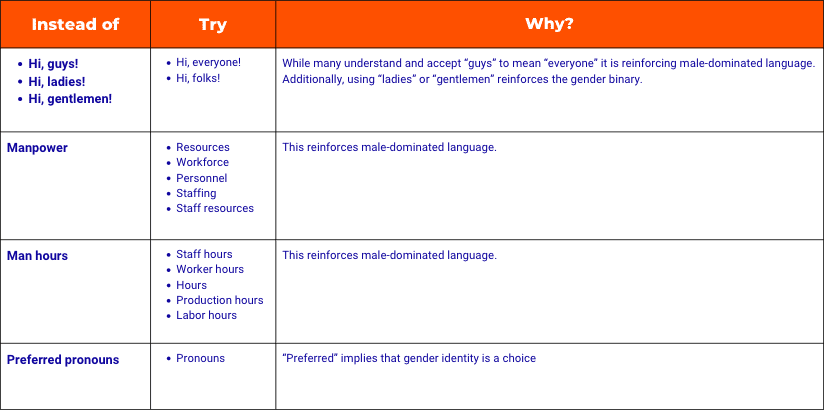
Ableist language
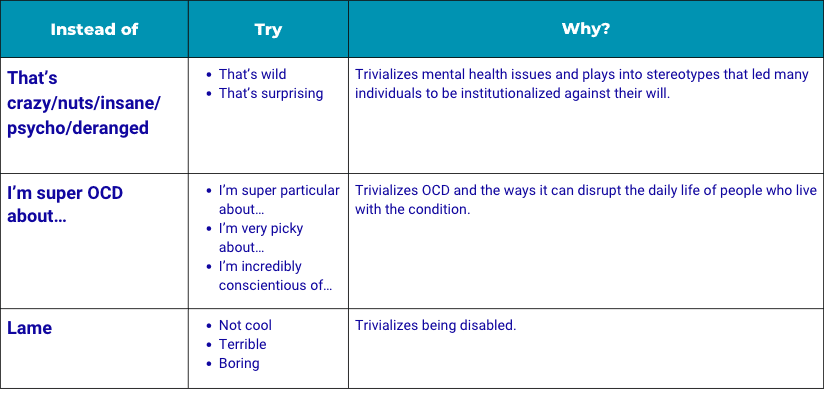
Racial or ethnic stereotypes and institutionalized racism
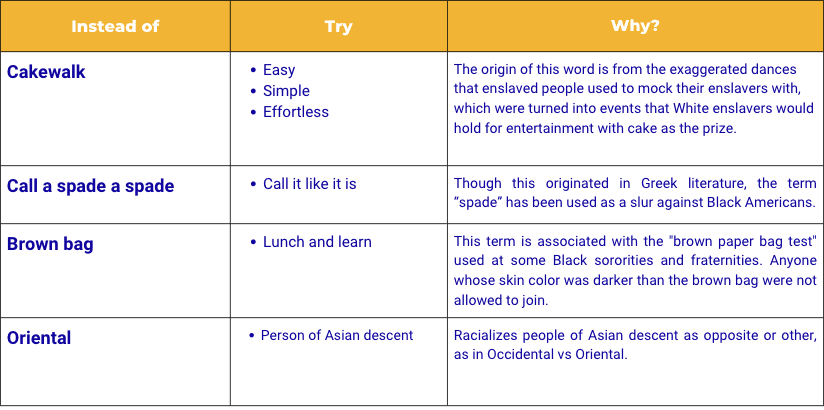
Ableist language
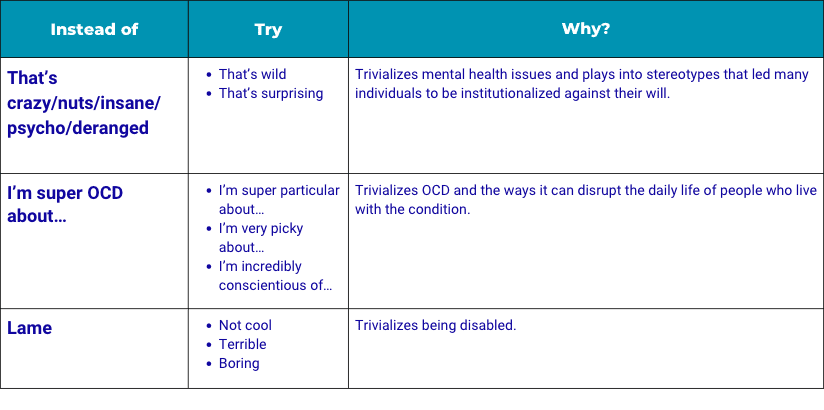
Culturally appropriative or insensitive language

Violent language
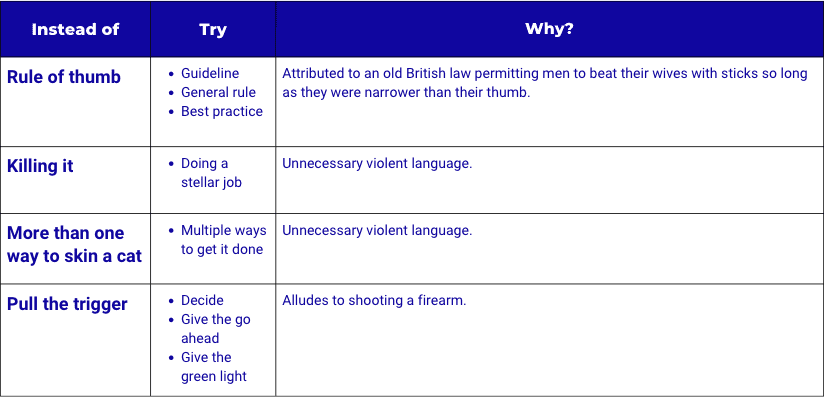
How to build inclusive language into your selling culture
Society’s definition of wrong and right will always be shifting and the language we use does, too. Taking the mindset that making simple substitutions to avoid the risk of hurting someone else will be a boon to any professional, but especially makes a difference for folks who interact with prospects and customers since building trust and a good reputation quickly is imperative to their success.
Using inclusive language is a muscle to be strengthened over time, like so many other interpersonal skills. Here are some ways to start baking it into your sales enablement efforts.
- Build inclusive language training into sales training and certification programs
- Use conversation intelligence tools to determine if additional training or competency development is needed
- Arm your sellers with sales content that’s reflective of inclusive language best practices
- Make sure your front-line sales managers are using inclusive language during their sales coaching conversations with sellers and are coaching them to do the same during their sales conversations
Make small changes, starting with the phrases you use most frequently. Choose one alternative to that phrase that you use consistently, then branch out to others when you feel like you’ve kicked the habit of using the original word or phrase. Give yourself and others room to make mistakes and be accountable for your words. A more inclusive world is built one positive interaction at a time.



 By Helen Waite
By Helen Waite

 By Rahul Mathew
By Rahul Mathew